It’s November already, the clocks have gone back and winter is well on the way. So how was October? Better than expected overall, we had several nice sunny days with light winds. Life at the patch continued as usual, we managed a fair bit of flying on the better days, often cutting the grass beforehand, making flying a reward for our hard work. As the weather is now turning colder mowing will hopefully be a rarity for a few months.
A herd of bullocks joined us for a while but were rarely a problem, once they realised we weren’t there to feed them they just wandered off and left us alone. Later in the month the bullocks went and were quickly replaced by a flock of sheep. Sheep never seem to be any bother other than the ‘presents’ they leave us! The last Sunday morning of October was a glorious, calm and sunny day so we took the opportunity to mow. As we finished mowing, right on cue, in the nick of too late, newbie Patrick turned up to fly. Patrick is fitting in well with the club and it’s about time he had a blog nickname so I’m wondering if being called Patrick Mower would nudge him into action. Of course that might make him think we see him as an 80’s TV star so maybe Patrick Non-Mower would be more appropriate!
Another new Petersfield Aero Modellers member Terry Small flew several times in October with his little HobbyZone Apprentice STOL. With a wingspan of just 700mm span the model is a scaled down version of the very popular E-flite 1500mm Apprentice.
 Terry also owns the larger Apprentice but I hear he damaged it while I was away for a few days. It’s almost ready to fly again now but Terry is awaiting delivery of a new wing spar.
Terry also owns the larger Apprentice but I hear he damaged it while I was away for a few days. It’s almost ready to fly again now but Terry is awaiting delivery of a new wing spar. 
Terry flies quite well with the smaller Apprentice and is using the gyro SAFE system in the Advanced mode as his skills improve. He was complaining that his simulator doesn’t mimic our long grass and windy conditions very well…welcome to the real-world Terry!
As well as the last Sunday of the month having perfect flying weather the morning was improved even further by Woody bringing along celebratory cakes for everybody!
His birthday was actually on the Friday before but the weather was not flyable that day.
Early in October Gordon Bennett managed to break the fuselage of his Multiplex Extra 330SC in half when landing. Gordon blamed the small wheels and spats, saying they stopped the Extra moving forward on the wet grass, and instead it nosed over and broke the fuselage at the back of the wing when the fin hit the ground. His solution was to remove the spats and replaced the wheels with ones about a foot in diameter.
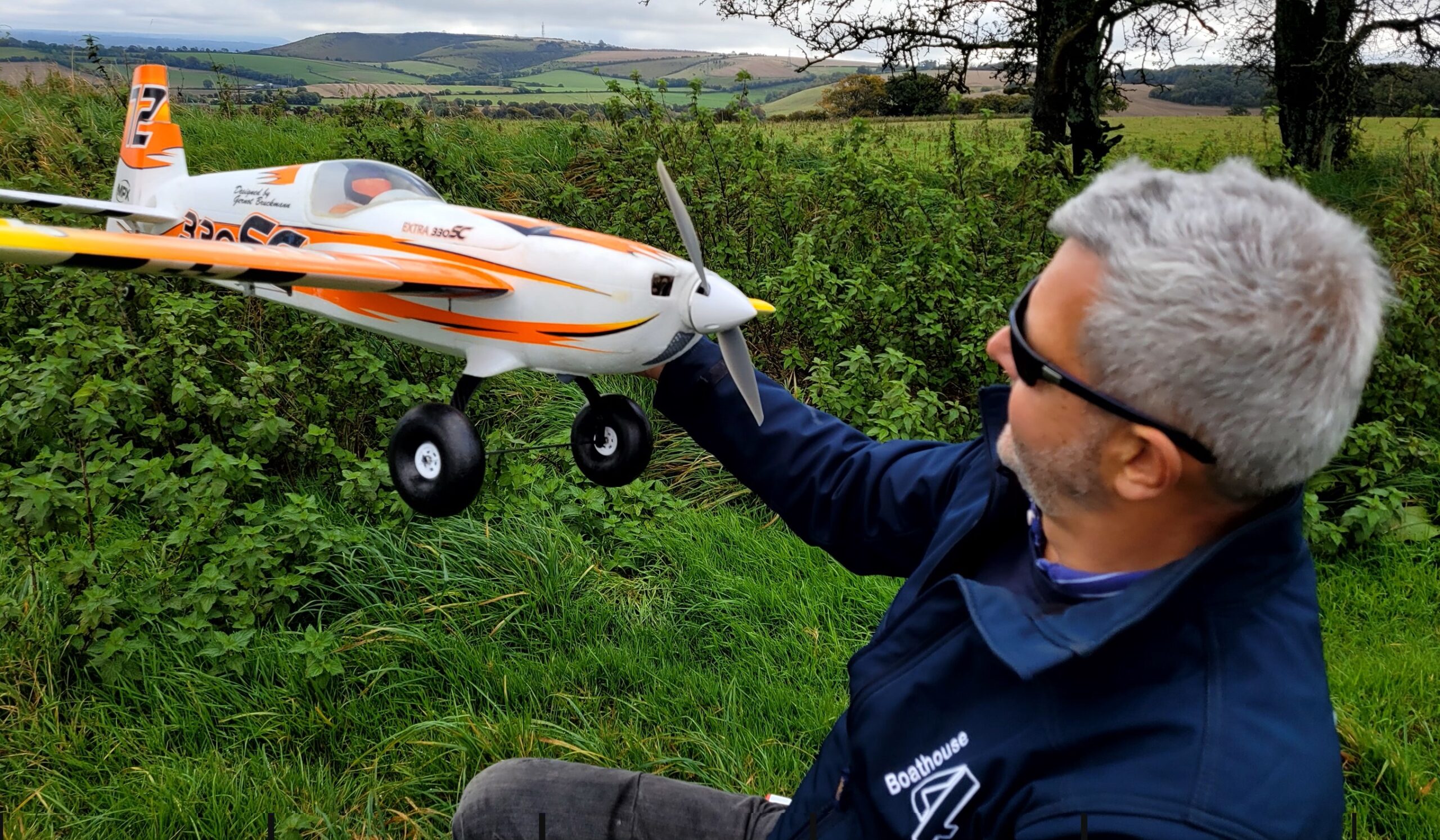 That might be a slight exaggeration but the wheels are much larger than the originals and don’t exactly enhance the look of the Extra. I think I know where he found his inspiration!
That might be a slight exaggeration but the wheels are much larger than the originals and don’t exactly enhance the look of the Extra. I think I know where he found his inspiration!  However, never mind what they look like, as you can see in this month’s video the bigger wheels do the job and Gordon has managed several flights without damaging anything.
However, never mind what they look like, as you can see in this month’s video the bigger wheels do the job and Gordon has managed several flights without damaging anything.
Last month I reported on the Multiplex Joker that Leo had bought at the Popham Model Show and subsequently sold on to Dougal Entendre. In October Dougal sorted out some of the things he wasn’t happy with on the plane and had a few flights at our field.
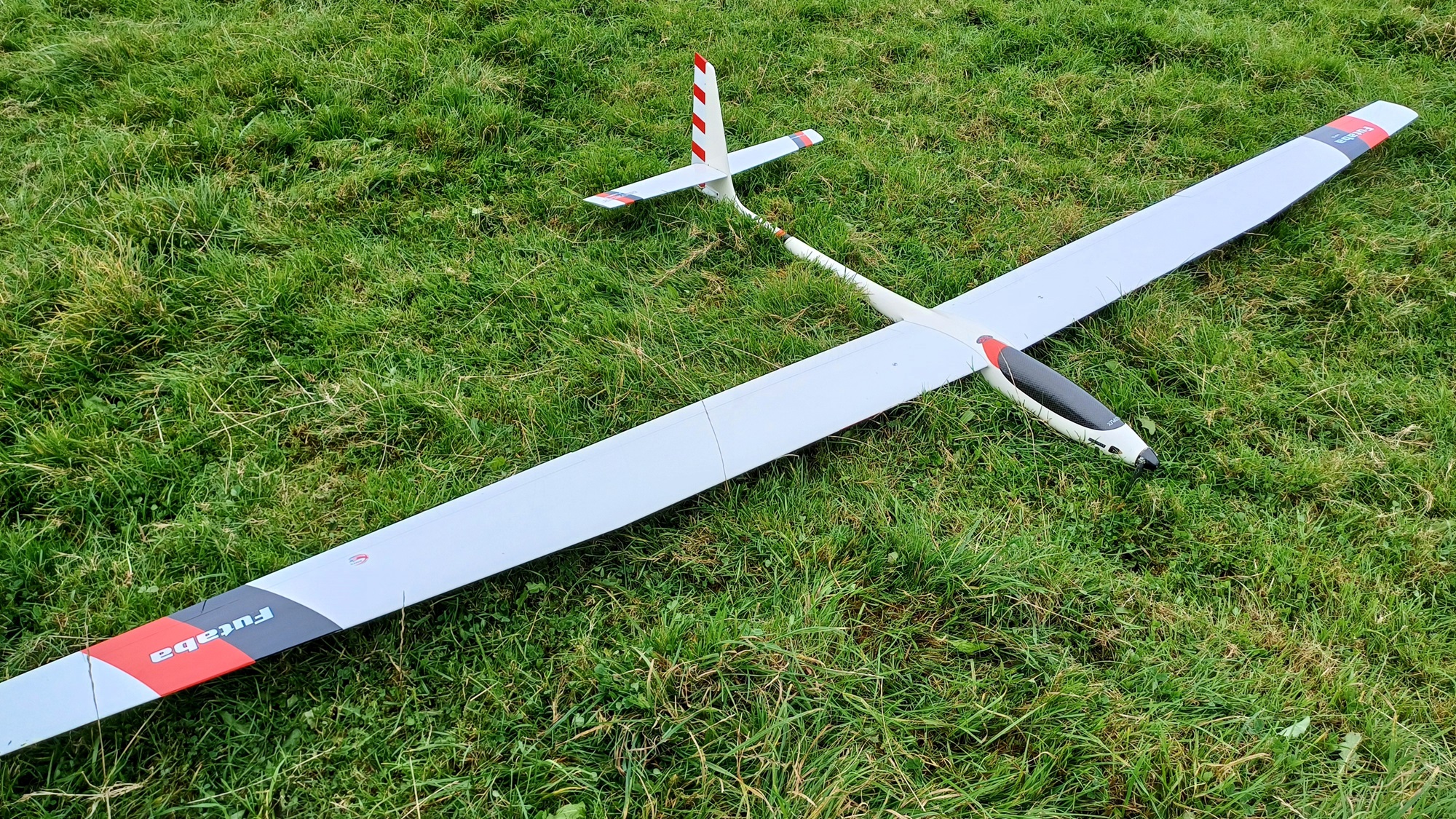 Here is Dougal’s report: Many years ago I designed a 12ft wingspan glider which I called Mr Blue Sky. I did a foam wing using obeche veneer attached with epoxy. The wings were heavy, which gave it an unfortunate characteristic of “digging in” when I tried to do slow thermal turns. This was probably due to tip-stalling, so I never had any success with it. Other designs with lighter built-up wings never seemed to suffer from this problem. When Leo purchased the Joker at Popham and we were heading back to the car with it, I worried that the wings seemed heavy, so it might suffer from a similar characteristic. Fortunately, when Leo had installed his gear and I got to test-fly it, it proved to be a fine performer with no nasty vices. I suspect the Joker performs so well due to its under-cambered section, straight wings (where Mr Blue Sky had polyhedral) and the really smooth epoxy covering job which the builder did. However, after the test flight, we still had to make a snagging list of things which were going to have to be sorted. It read as follows:
Here is Dougal’s report: Many years ago I designed a 12ft wingspan glider which I called Mr Blue Sky. I did a foam wing using obeche veneer attached with epoxy. The wings were heavy, which gave it an unfortunate characteristic of “digging in” when I tried to do slow thermal turns. This was probably due to tip-stalling, so I never had any success with it. Other designs with lighter built-up wings never seemed to suffer from this problem. When Leo purchased the Joker at Popham and we were heading back to the car with it, I worried that the wings seemed heavy, so it might suffer from a similar characteristic. Fortunately, when Leo had installed his gear and I got to test-fly it, it proved to be a fine performer with no nasty vices. I suspect the Joker performs so well due to its under-cambered section, straight wings (where Mr Blue Sky had polyhedral) and the really smooth epoxy covering job which the builder did. However, after the test flight, we still had to make a snagging list of things which were going to have to be sorted. It read as follows:
1. No ESC brake, so the folding propeller would not fold.
2. Flaps would only work like ailerons, i.e. one went up when the other went down!
3. Vibration at full throttle.
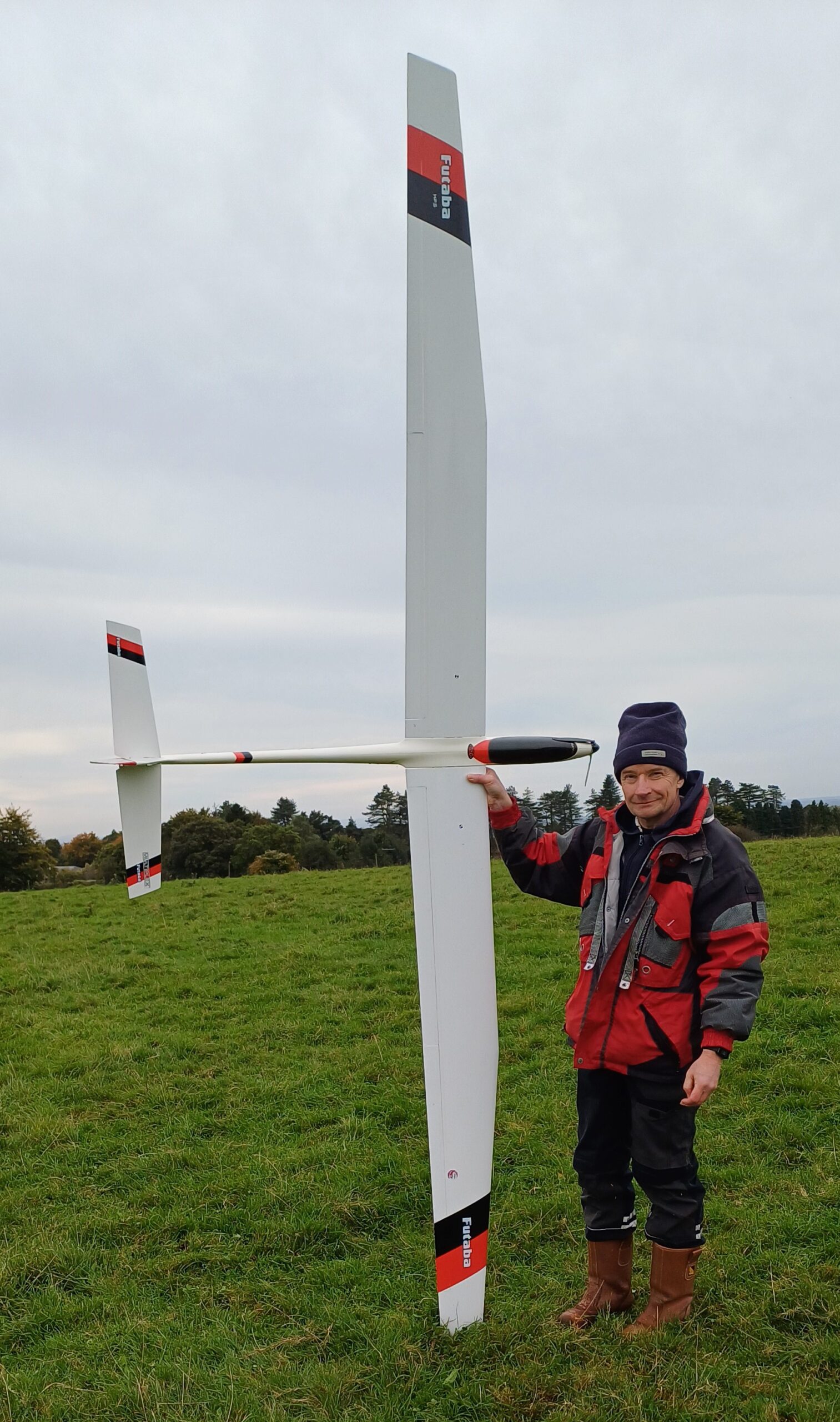 I bought the Joker off Leo, got it in the workshop and approached each problem in turn. It had an Arrows 50A ESC fitted (which I think is the same as used in the Marlin), so I downloaded the instructions and tried to engage the brake.
I bought the Joker off Leo, got it in the workshop and approached each problem in turn. It had an Arrows 50A ESC fitted (which I think is the same as used in the Marlin), so I downloaded the instructions and tried to engage the brake.
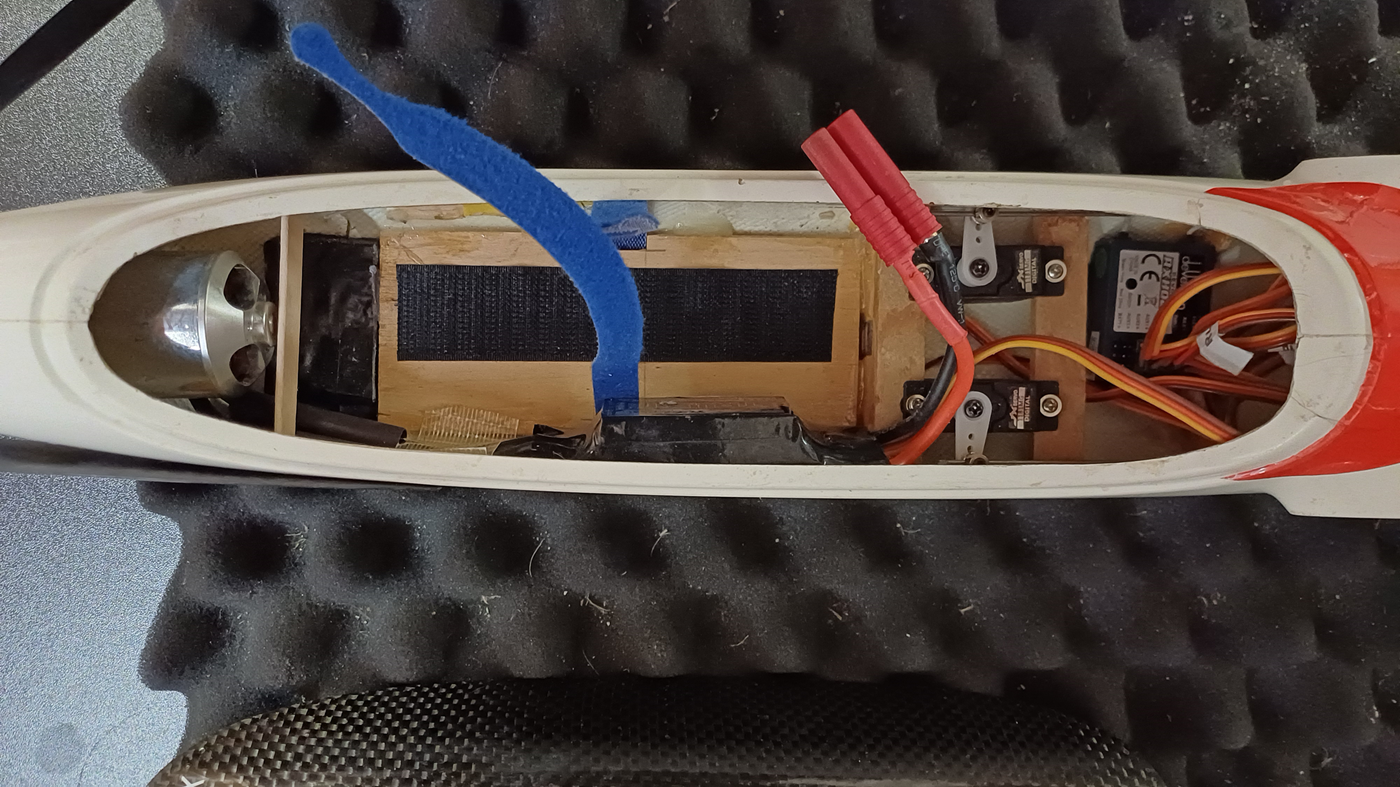 This proved impossible – the ESC didn’t respond to programming using the throttle stick as it should, so I replaced it with a different ESC where I knew the brake worked. I suspect the Arrows unit doesn’t actually have a brake, even though the instructions suggest that it does! The flap problem was solved by removing the Y-lead which the original owner had put in the wiring harness, and driving each servo off a separate Rx channel, with suitable reversing. I did the same for the ailerons, removing the second Y-lead and using separate channels so I could program some differential (more up aileron than down). The propeller seemed to be well balanced, but using a 4s pack at full throttle gave a nasty vibration. Throttling back to about 75% gave no vibration at all, and the model still proved to have a good climb rate, so my temporary solution is to put a limit on the throttle when using 4s batteries. In the long term I may go down to 3s, but that will mean changing the ESC connector! In the meantime I’m using a 4s 3700mAh pack, and used less than 20% capacity for a 12-minute flight in fairly still air.
This proved impossible – the ESC didn’t respond to programming using the throttle stick as it should, so I replaced it with a different ESC where I knew the brake worked. I suspect the Arrows unit doesn’t actually have a brake, even though the instructions suggest that it does! The flap problem was solved by removing the Y-lead which the original owner had put in the wiring harness, and driving each servo off a separate Rx channel, with suitable reversing. I did the same for the ailerons, removing the second Y-lead and using separate channels so I could program some differential (more up aileron than down). The propeller seemed to be well balanced, but using a 4s pack at full throttle gave a nasty vibration. Throttling back to about 75% gave no vibration at all, and the model still proved to have a good climb rate, so my temporary solution is to put a limit on the throttle when using 4s batteries. In the long term I may go down to 3s, but that will mean changing the ESC connector! In the meantime I’m using a 4s 3700mAh pack, and used less than 20% capacity for a 12-minute flight in fairly still air.
 I have no idea what the motor is (and I’m not going to remove it to see), but I think a 3s pack should be fine if I add a bit more nose-weight. Thanks for that Dougal, good stuff.
I have no idea what the motor is (and I’m not going to remove it to see), but I think a 3s pack should be fine if I add a bit more nose-weight. Thanks for that Dougal, good stuff.
The Joker has connectors mounted in the wing roots that mate with ones in the fuselage so there’s no faffing around with connectors when it’s assembled at the field.

It looked great in the air and floated around well even though there appeared to be no lift.
Following a mid-air collision that wrote-off his E-Flite F-15 Eagle Woody saved all the important and undamaged parts and has now fitted them into an F-18 Super Hornet that he bought from AliExpress. I can’t tell you which one as Woody seems to have bought the last one and it’s no longer listed. It was a bare airframe listed at £29.98 but by the time VAT and delivery had been added it cost around £56, so not quite such a bargain.

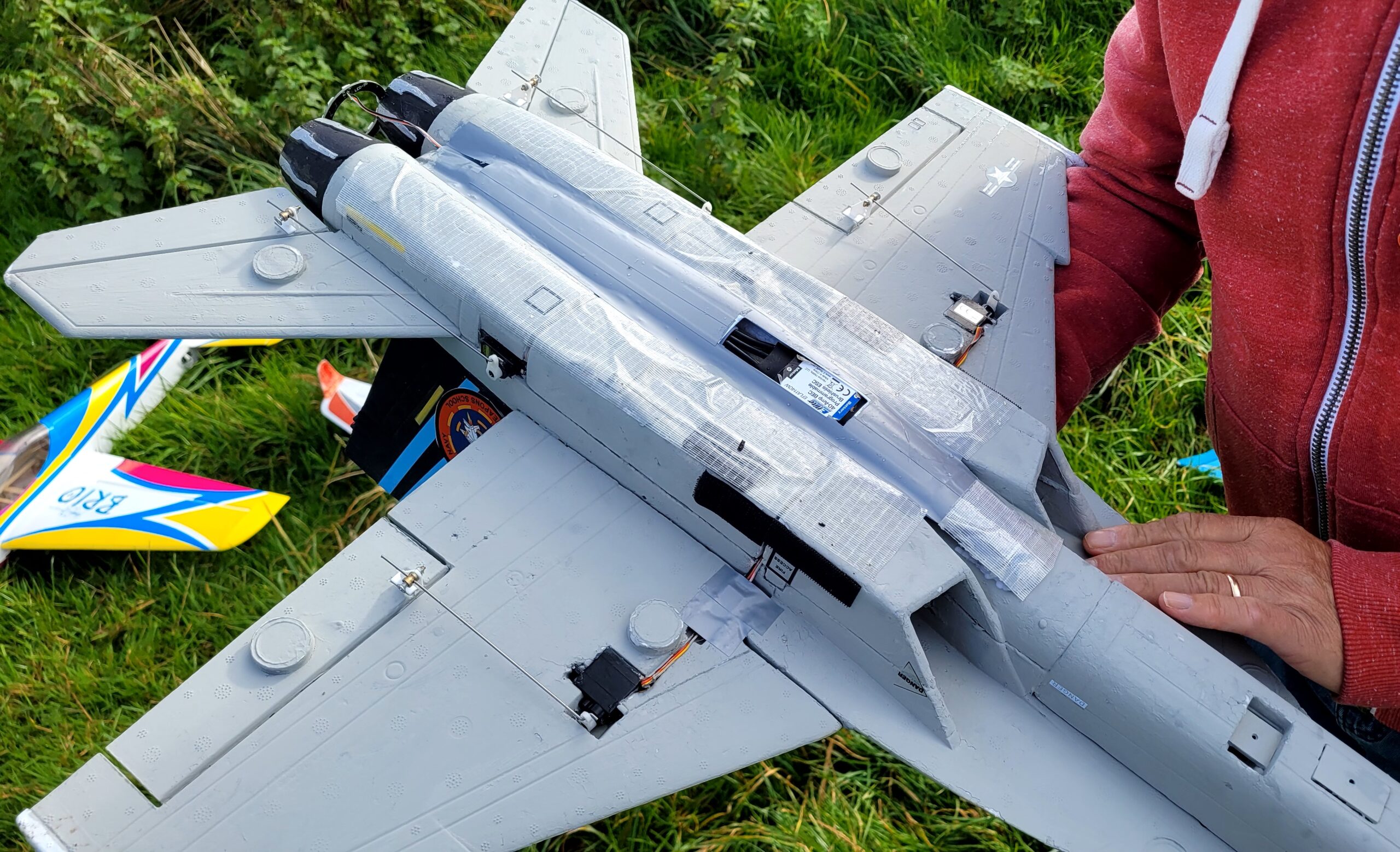 Woody fitted the F-18 with the 64mm fan and motor from the F-15 along with the 40A speed controller and four servos. He finished the Hornet with acrylic paints and of course, as this is Woody I’m talking about, he also added a reheat led light ring at the rear.
Woody fitted the F-18 with the 64mm fan and motor from the F-15 along with the 40A speed controller and four servos. He finished the Hornet with acrylic paints and of course, as this is Woody I’m talking about, he also added a reheat led light ring at the rear.
 A pair of light rings would have been the more appropriate but he somehow managed to blow one up! The finished model looks smart and being much the same size and weight as the E-flite Eagle it should have enough power, so does it fly? Yes! Woody was unsure of the correct centre of gravity position and the first attempt at flight showed that it was much too far back. So lots of lead was temporarily added to the nose and another attempt made.
A pair of light rings would have been the more appropriate but he somehow managed to blow one up! The finished model looks smart and being much the same size and weight as the E-flite Eagle it should have enough power, so does it fly? Yes! Woody was unsure of the correct centre of gravity position and the first attempt at flight showed that it was much too far back. So lots of lead was temporarily added to the nose and another attempt made.  This time the C of G was too far forward and the Eagle wouldn’t climb away from the launch so some of the lead was removed. The next attempt showed the C of G was now correct and it went away from the launch and flew very nicely. Well done Woody, try not to break it! All three attempts and successful flight can be seen in this month’s video.
This time the C of G was too far forward and the Eagle wouldn’t climb away from the launch so some of the lead was removed. The next attempt showed the C of G was now correct and it went away from the launch and flew very nicely. Well done Woody, try not to break it! All three attempts and successful flight can be seen in this month’s video.
Young Leo has spent the money Dougal paid him for the Joker (but not on 3 cell 2200mAh batteries apparently!) and has bought a HobbyKing Paramotor V2. Bob the Builder built a few paramotor models several years ago, before the first HobbyKing one was available and had rather limited success with them although it was an interesting trial. But the HobbyKing one seems to be pretty well sorted, particularly the new V2 version.
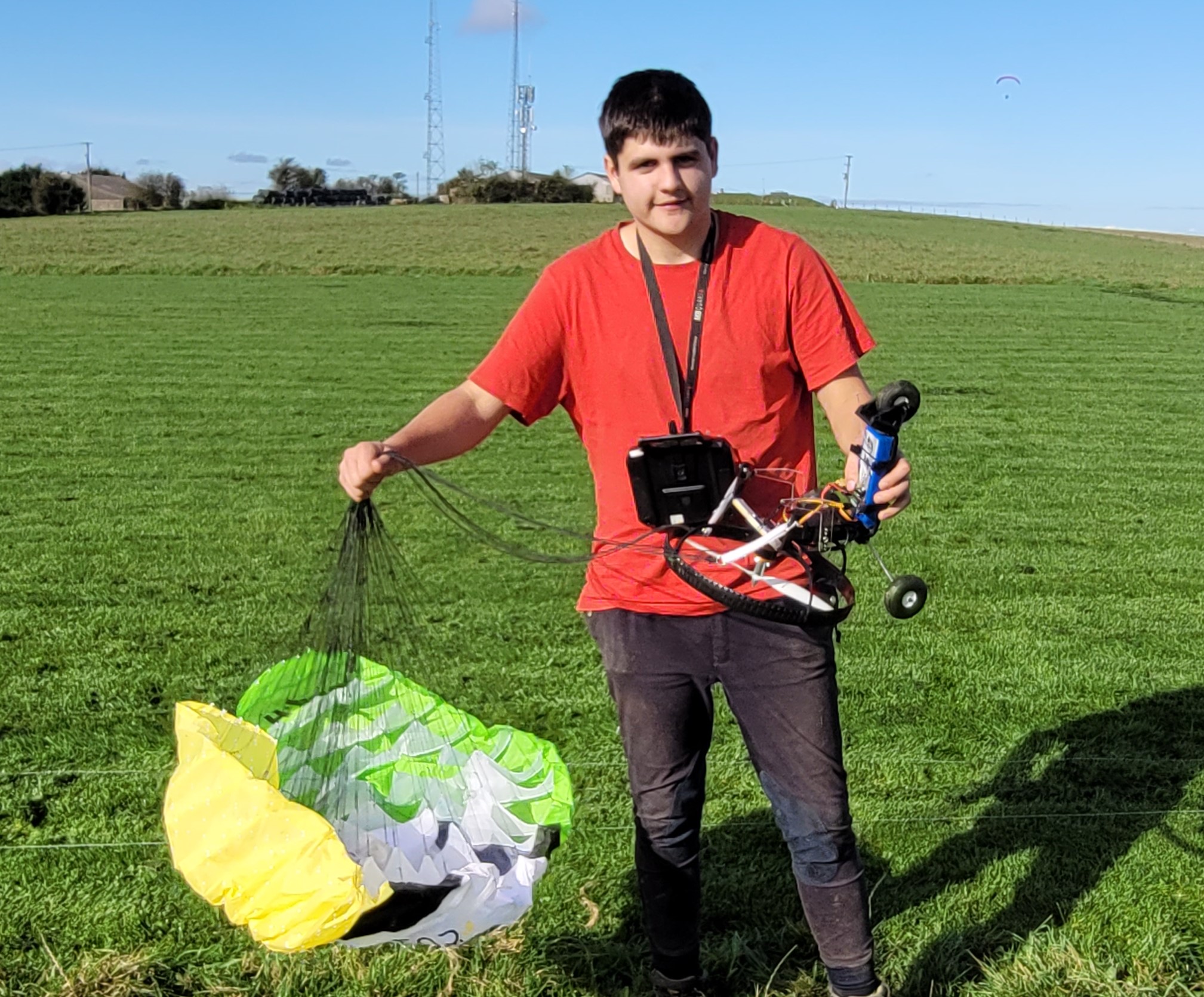 The first couple of attempts at flight didn’t go to plan but after a bit of checking, consulting everyone, and listening to various differing opinions Leo reversed the aileron control and away it went. As it happened there were a couple of full-size paramotors flying as well and I managed to snap some photos that included a full-size one as well as Leo’s.
The first couple of attempts at flight didn’t go to plan but after a bit of checking, consulting everyone, and listening to various differing opinions Leo reversed the aileron control and away it went. As it happened there were a couple of full-size paramotors flying as well and I managed to snap some photos that included a full-size one as well as Leo’s.
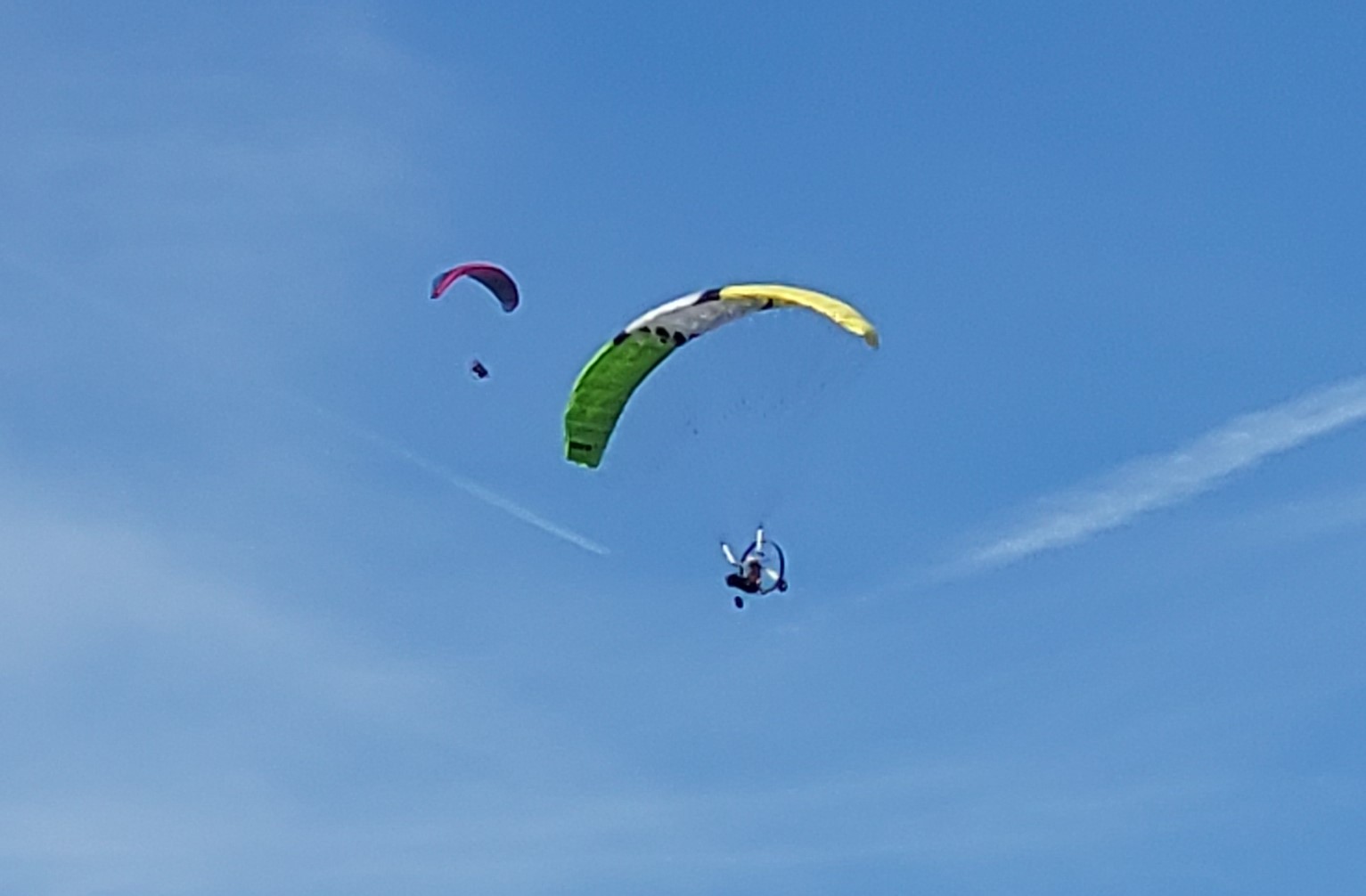
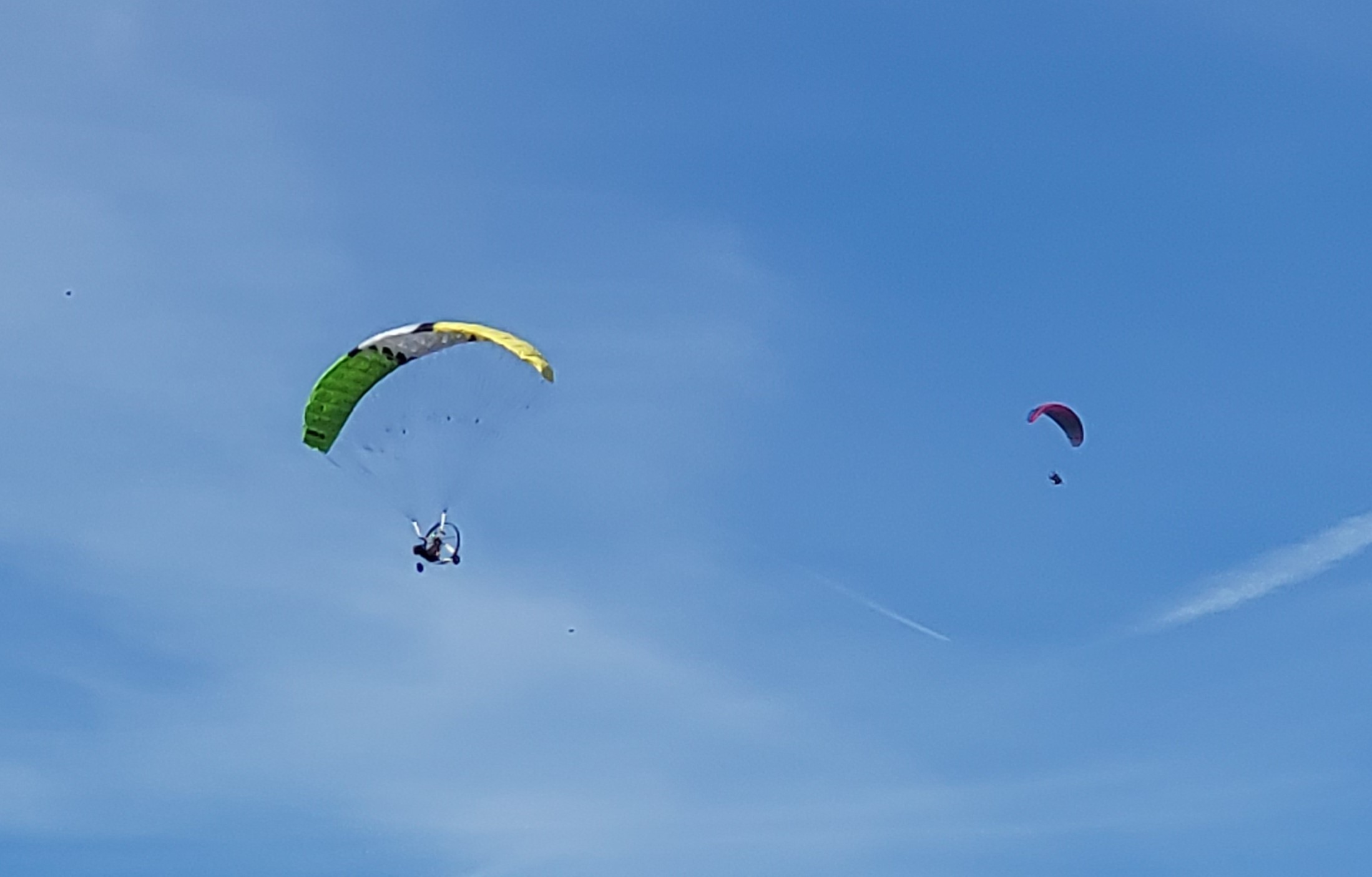 The shots were taken with a high zoom setting and the at no point did the model get remotely close to the full-sized one. Leo didn’t seem to have any problems with the Paramotor and had a long flight followed by a perfect landing back on the patch.
The shots were taken with a high zoom setting and the at no point did the model get remotely close to the full-sized one. Leo didn’t seem to have any problems with the Paramotor and had a long flight followed by a perfect landing back on the patch.
 This is from the HobbyKing website: Following on from the incredible success of the first H-King Paramotor comes this V2. The V2 still retains many of the characteristics of the original version, including the ability to perform loops and rolls with ease after a little practice. The large area high performance 2400mm parafoil wing opens quickly for easy launching and due to its design it will retain its shape even in severe turbulence. The single-skin durable wing is made from 100% ripstop fabric and the new, stronger nylon chords are rigged and ready to attach to the durable aluminium gondola. Just like the original version, there is a high level of prefabrication so assembly time is kept to a minimum, and as it is supplied in a Plug-N-Fly format all you will require to get flying is your transmitter, receiver, LiPo battery, and charger. The Paramotor V2 is fitted with a powerful 3530-1400KV brushless motor swinging a 10×4.7 propellor, has a 50A electronic speed controller with 5A BEC, and 2 powerful 15kg high torque metal geared servos. A 3S LiPo battery is recommended and it can vary in capacity to suit different flying conditions. The recommended flying weight is 1.6~2.0kg, in light wind conditions it is best to put a lighter battery in to keep near the 1.6kg weight. In windy conditions, it is better to put a heavier battery in to fly around the 2kg mark. Ultra-long flights of 20~45mins can be achieved depending on the size of the battery used.
This is from the HobbyKing website: Following on from the incredible success of the first H-King Paramotor comes this V2. The V2 still retains many of the characteristics of the original version, including the ability to perform loops and rolls with ease after a little practice. The large area high performance 2400mm parafoil wing opens quickly for easy launching and due to its design it will retain its shape even in severe turbulence. The single-skin durable wing is made from 100% ripstop fabric and the new, stronger nylon chords are rigged and ready to attach to the durable aluminium gondola. Just like the original version, there is a high level of prefabrication so assembly time is kept to a minimum, and as it is supplied in a Plug-N-Fly format all you will require to get flying is your transmitter, receiver, LiPo battery, and charger. The Paramotor V2 is fitted with a powerful 3530-1400KV brushless motor swinging a 10×4.7 propellor, has a 50A electronic speed controller with 5A BEC, and 2 powerful 15kg high torque metal geared servos. A 3S LiPo battery is recommended and it can vary in capacity to suit different flying conditions. The recommended flying weight is 1.6~2.0kg, in light wind conditions it is best to put a lighter battery in to keep near the 1.6kg weight. In windy conditions, it is better to put a heavier battery in to fly around the 2kg mark. Ultra-long flights of 20~45mins can be achieved depending on the size of the battery used.
It will be interesting to see how the Paramotor performs in stronger winds but in the light winds when Leo flew it there didn’t appear to be any problems at all. MacFly recorded a lot of the first three flights and you can see some of it in this month’s video.
Watching Leo fly his new Paramotor inspired Bob the Builder to dig out a powered hang glider that he hadn’t flown for several years. Bob has changed his transmitter since the last flight with it so everything needed setting up again but after one false start followed by a couple of adjustments the model flew surprisingly well in the light wind of the day.
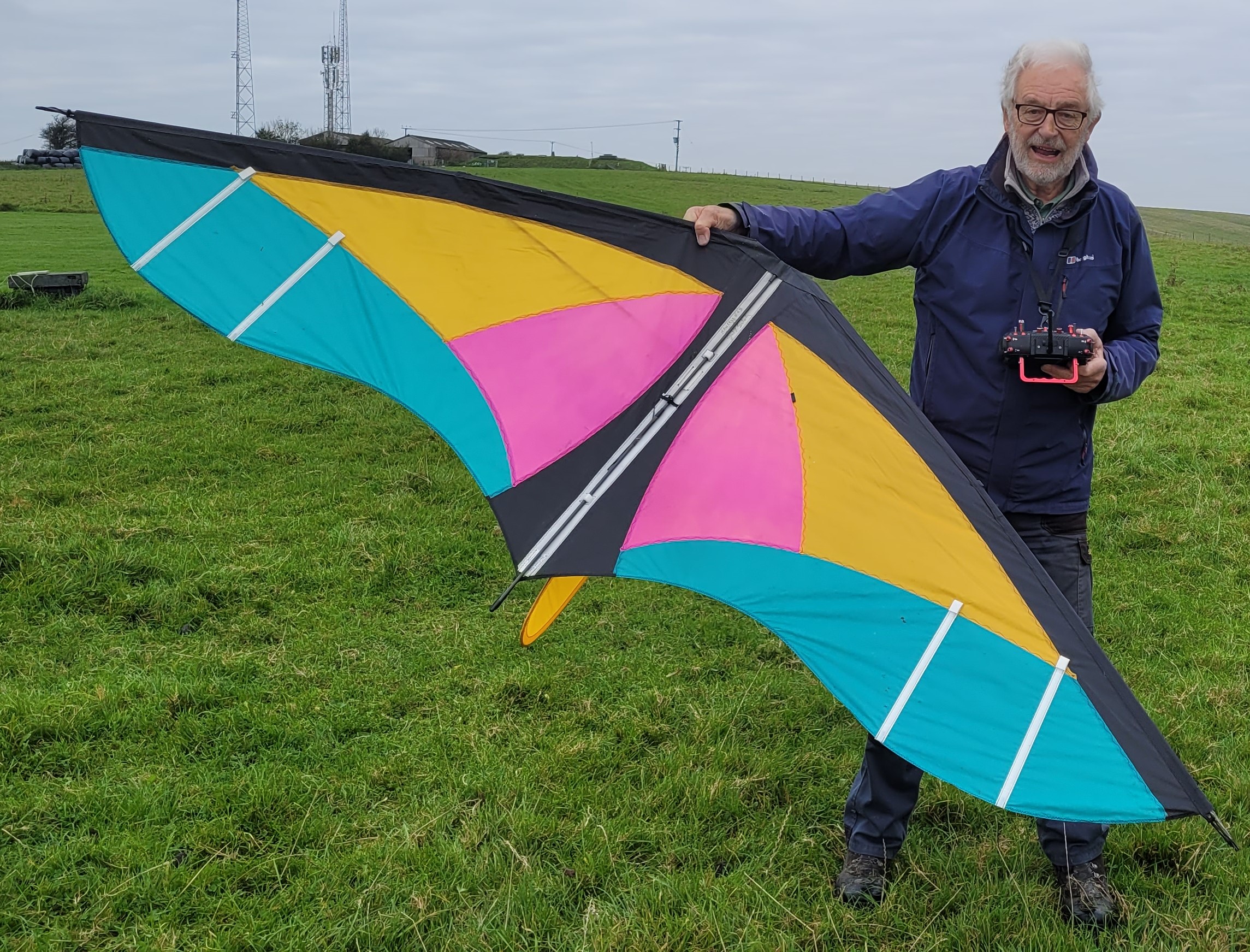
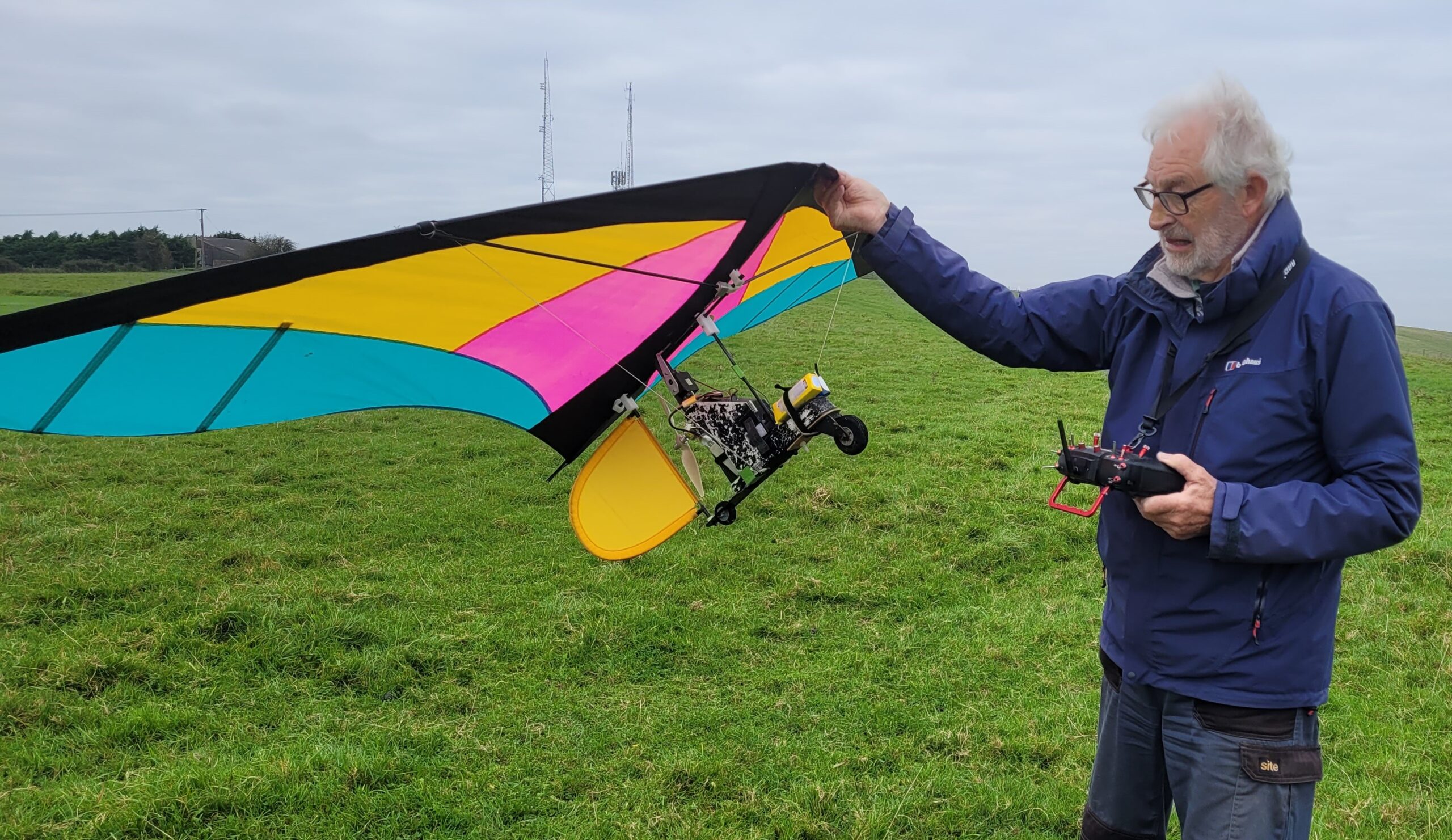 MacFly took some video for us but as it was on 30th October it was too late to be include in this month’s video but it will be something to look forward to next month!
MacFly took some video for us but as it was on 30th October it was too late to be include in this month’s video but it will be something to look forward to next month!
This month the ‘action shots’ are all taken from the video so not the best quality I’m afraid: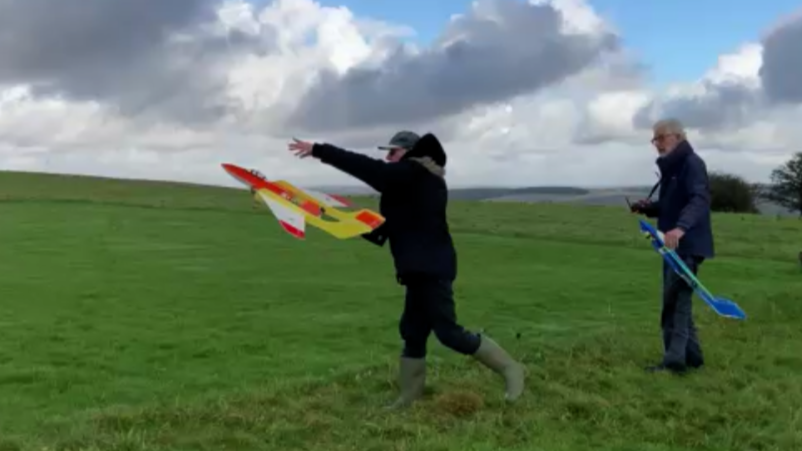
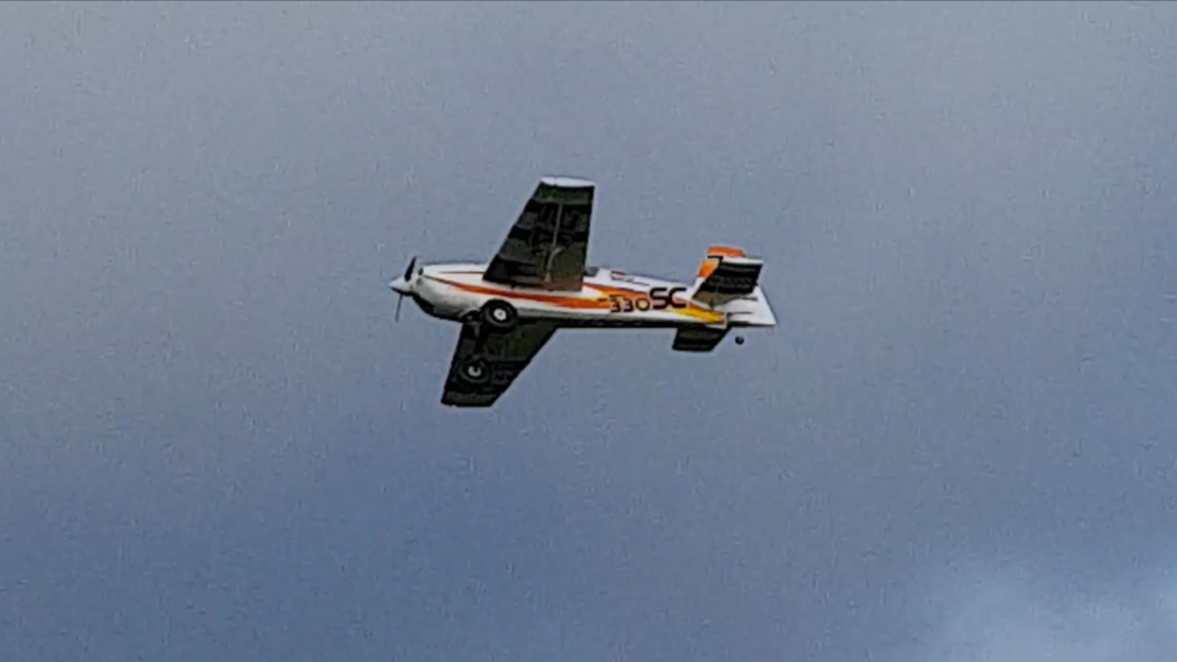
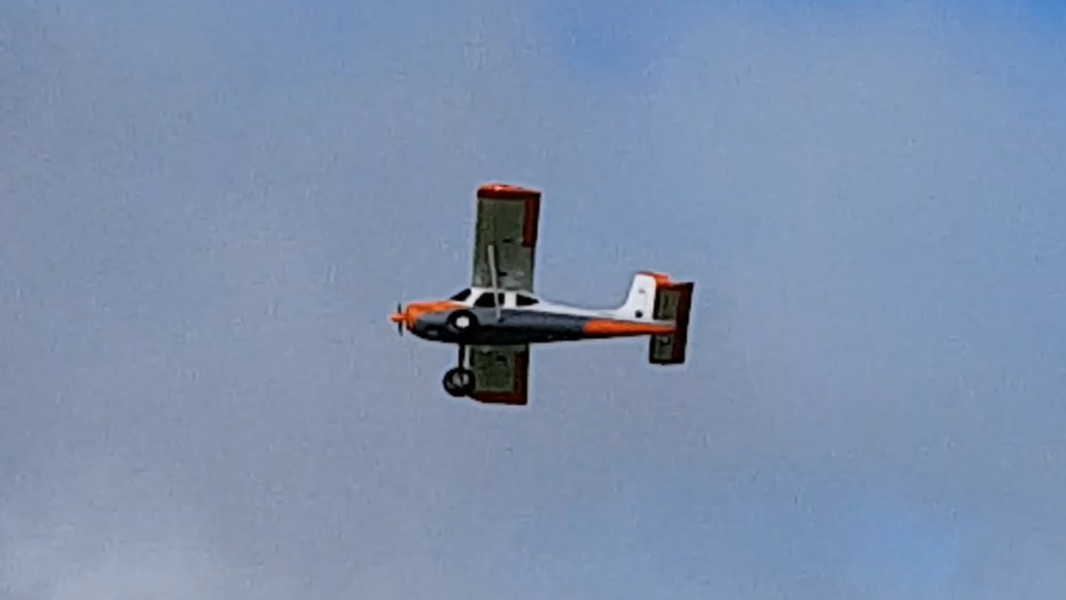

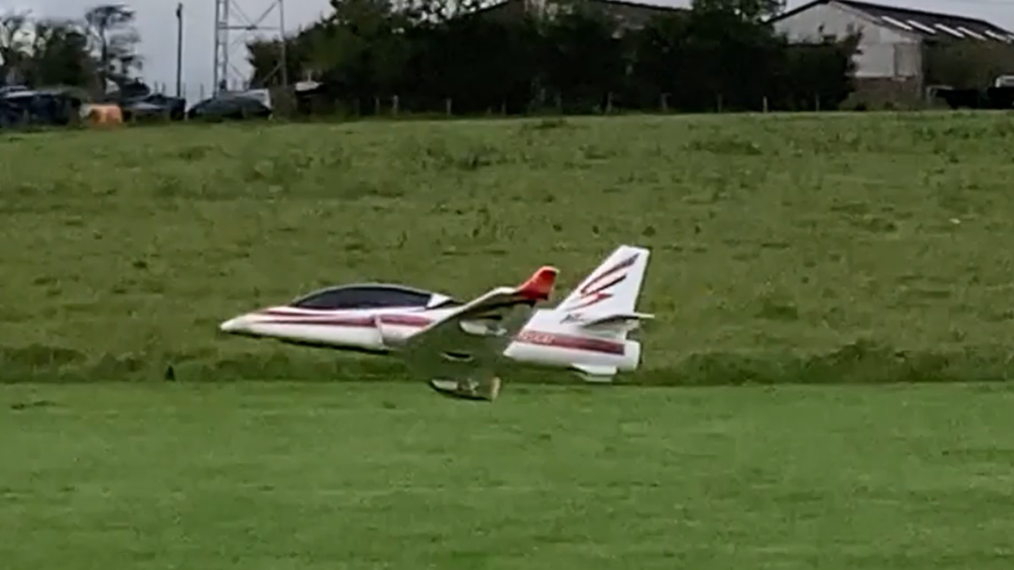

Video time now, this month with footage taken by myself and MacFly. Please watch the video full-screen, it’s so much better with small models flying around:
If the video won’t play for you please click HERE
Marry someone who says things like:
I’m proud of you…
You can do it darling…
I can’t believe you’re mine…
I don’t know where that extra aeroplane came from but it looks amazing alongside all the others and I think we’re going to need a bigger hangar.
Colin Cowplain


Thanks Colin for all the work you put into patch news.
Nice one Colin excellent vlog plus you managed to fit in a holiday as well.
Well done Patsie, great work as always. Big up for McFly’s video work as well.
Thanks for the comments chaps, it’s always nice to know that some people read read it!